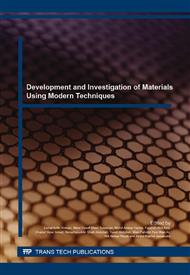p.375
p.381
p.389
p.394
p.399
p.404
p.410
p.416
p.421
Chemical, Thermal and Phase Analysis of Malaysia’s Electric Arc Furnace (EAF) Slag Waste
Abstract:
This study aims to characterize and investigate properties of EAF slag waste obtained from Southern Steel Berhad, Penang (one of Malaysia’s largest steel makers), prior to its recycling into valuable products. Before characterization, lump form of the EAF slag was crushed into micron size powder. The properties investigated were loss of ignition (L.O.I.), chemical composition, leaching behavior, thermal properties and mineral phases present. Through XRF characterization, the chemical composition of the EAF slag was obtained. The slag was found to have extremely low L.O.I. (0.01 wt.%). Leaching test proved the slag is non-hazardous and safe to be handled. Meanwhile, thermal analysis (TGA) revealed the EAF slag is thermally stable and unlikely to decompose upon heating. Phase identification and quantification were performed by applying Rietveld refinement method. The EAF slag consisted of gehlenite (Al2O3.2CaO.SiO2 – 45.3 wt.%), larnite (2CaO.SiO2 – 21.0 wt.%), hematite (Fe2O3 – 13.4 wt.%) and wustite (FeO – 20.3 wt.%) mineral phases. The XRD profile fitted well with agreement indices of the refinement (Rwp: 6.658 and GOF: 2.588). The properties investigated in this study are expected to shed lights in evaluating the potential recycling of the EAF slag into various valuable products such as aggregate, brick, ceramic tile and cementing material.
Info:
Periodical:
Pages:
399-403
Citation:
Online since:
January 2016
Authors:
Price:
Сopyright:
© 2016 Trans Tech Publications Ltd. All Rights Reserved
Share:
Citation:


